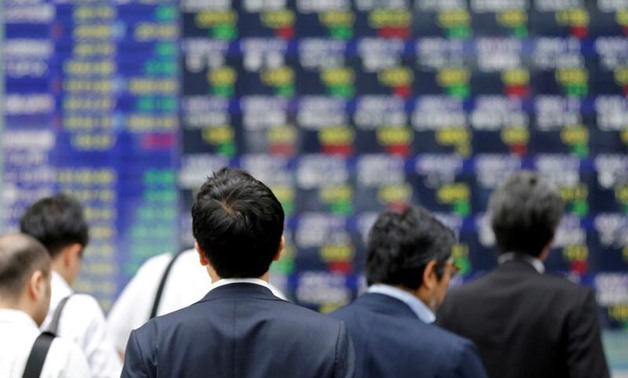
FILE PHOTO: People walk past an electronic stock quotation board outside a brokerage in Tokyo, Japan, September 22, 2017. REUTERS/Toru Hana
TOKYO - 14 June 2018: Asian shares eased on Thursday after the Federal Reserve raised interest rates and struck a more hawkish tone by forecasting a slightly faster tightening, while concerns about weak Chinese data and U.S.-China trade frictions kept investors on edge.
Surprisingly weak Chinese retail sales and urban investment data curbed investors’ risk appetite by adding to doubts over the world’s second-largest economy as its central bank unexpectedly left interest rates on hold rather than follow the Fed higher.
European shares are expected to fall, with spread-betters looking at a lower opening of 0.4 percent in Britain's FTSE .FTSE, 0.3 percent in Germany's Dax .GDAXI and 0.2 percent in France's CAC .FCHI.
MSCI's broadest index of Asia-Pacific shares outside Japan .MIAPJ0000PUS lost 1.0 percent, with shares in South Korea .KS11 and Taiwan .TWII falling over one percent.
Japan's Nikkei .N225 lost 0.6 percent while in mainland China, Shanghai composite index .SSEC is on course to hit a 20-month closing low, shedding 0.4 percent.
The Fed raised its benchmark overnight lending rate a quarter of a percentage point to a range of 1.75 percent to 2 percent, as expected, on the back of strong U.S. economic growth.
Fed policymakers’ rates projections pointed to two additional hikes by the end of this year compared to one previously, based on board members’ median forecast.
“The Fed was slightly more hawkish. But at the same time, the Fed is raising rates because of a strong economy and not because of the need to contain inflation. So that might have helped curb market reactions,” said Masayuki Kichikawa, chief macro strategist at Sumitomo Mitsui Asset Management.
The spectre of higher borrowing costs hit stocks while boosting U.S. bond yields and the dollar. The overall market reaction was short-lived, however.
“When you look more closely, only eight board members saw two more hikes by the end of year, compared to seven who saw one hike. In March it was seven versus eight. So you are talking about a change of only one board member after all,” said Norihiro Fujito, senior investment strategist at Mitsubishi UFJ Morgan Stanley Securities.
“The fact that markets quickly reversed their course suggests the Fed’s decision was broadly in line with expectations,” he said.
On Wall Street, the S&P 500 .SPX lost 0.40 percent and the Nasdaq Composite .IXIC dropped 0.11 percent.
The 10-year U.S. Treasuries yield hit a three-week high of 3.010 percent before quickly slipping back to 2.948 percent US10YT=RR.
Fed funds rate futures <0#FF:> are pricing in a little over 50 percent chance of two more rate hikes this year, a small change from around 50 percent priced in before the Fed’s decision.
While the Fed slightly accelerated the pace of rate hikes in coming months, it dropped a reference from the statement that interest rates are likely to remain below levels that are expected to prevail in the longer run.
“That gave reassurance to markets that Fed policy board members were also discussing an eventual end in its process to remove stimulus,” said Hiroshi Yokotani, portfolio strategist at State Street Global Advisors.
Keeping investors in check were concerns about U.S. threats to impose tariffs on billions of dollars in Chinese goods.
U.S. President Donald Trump will meet with his top trade advisers on Thursday to decide on whether to activate the tariffs, a senior Trump administration official said.
In the currency market, the dollar had erased all its post-Fed gains as traders’ focus quickly shifted to the European Central Bank’s policy meeting later in the day.
Recent comments from top ECB officials have sparked expectations the ECB may offer clues on its intentions to end its bond purchases by the end of the year at its upcoming meeting.
The euro traded at $1.1801 EUR=, bouncing back from $1.1725 hit after the Fed's policy announcement and not far off last week's high of $1.1840 on June 7.
The dollar stood at 110.06 yen JPY=, losing steam after hitting a three-week high of 110.85 in the wake of the Fed's decision.
The dollar index has erased all of its gains so far this week and stood at 93.481 .DXY.
The Australian dollar fell 0.35 percent to $0.7551 AUD=D4 after China reported weaker-than-expected activity data for May, adding to views the economy is finally starting to slow under the weight of a prolonged crackdown on riskier lending that is pushing up borrowing costs for companies and consumers.
Some emerging market currencies have been hit by worries higher U.S. interest rates could prompt investors to shift funds to the United States and also squeeze dollar borrowers in emerging markets.
The South African rand hit six-month lows ZAR=D3 while the Mexican peso dropped to 16-month lows MXN=D2. The Turkish lira TRY= and the Brazilian real BRL= also stayed under pressure due to domestic political woes.
Still, many Asian currencies remained fairly stable so far, thanks to robust growth in the region.
Oil prices were little changed but underpinned by a bigger-than-expected decline in U.S. crude inventories and surprise drawdowns in gasoline and distillates, which indicated strong demand in the world’s top oil consumer.
U.S. crude futures CLc1 traded at $66.67 a barrel, unchanged on the day but extending their recovery from eight-week low of $64.22 touched last week.


Comments
Leave a Comment